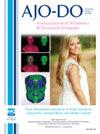Assessment of virtual bracket removal by artificial intelligence and thermoplastic retainer fit
IF 2.7
2区 医学
Q1 DENTISTRY, ORAL SURGERY & MEDICINE
American Journal of Orthodontics and Dentofacial Orthopedics
Pub Date : 2024-11-20
DOI:10.1016/j.ajodo.2024.07.020
引用次数: 0
Abstract
Introduction
Digital orthodontics is here to make our specialty more efficient, and the integration of artificial intelligence (AI) is no exception. This study aimed to compare the accuracy of a workflow involving virtual bracket removal (VBR) by AI to traditional bracket removal. A secondary objective was to compare the clinical fit of thermoplastic orthodontic retainers fabricated from 3-dimensional (3D) printed models created by each method.
Methods
Thirty dental arches were scanned intraorally with the fixed labial orthodontic brackets in place, creating 30 standard tessellation language (STL) files which were labeled “pre-debond.” For each patient, all brackets and residual adhesive were then clinically removed, and an additional intraoral scan was taken and labeled “post-debond.” Each pre-debond scan was uploaded to the uDesign by uLab software (version 7.0; uLab Systems, Inc, Memphis, Tenn), which uses AI to virtually remove orthodontic brackets using 1-touch bracket identification. New STL files were created for each of the 30 arches and labeled VBR. Best fit superimpositions were performed using Geomagic Control X (3D Systems, Inc, Rock Hill, SC), and data were collected as both numerical values and color-coded deviation maps. Superimposition data were segmented for each arch (anterior, posterior right, and posterior left) to determine if the arch location was a relevant factor. All post-debond and VBR STL files were 3D printed. Thermoplastic retainers were fabricated on each 3D-printed model. Retainers were delivered to patients and clinically graded by 2 practitioners.
Results
There was a statistically significant difference in standard deviation and out-of-tolerance percentage values when comparing traditional debonded arches and virtually debonded arches when using sextant locations as a factor (anterior, posterior right, and posterior left). Grading scores for both evaluators show a statistically significant difference for the evaluation of facial surface adaptation and snap-fit acceptability between retainer fabrication methods. However, there was no correlation between out-of-tolerance values and clinical retainer fit evaluation among any of the graded variables in either the maxillary or mandibular arches.
Conclusions
VBR by AI is considered accurate enough to be used for the fabrication of clinically acceptable thermoplastic orthodontic retainers.
通过人工智能和热塑保持器配合评估虚拟托架去除情况。
导言:数字化正畸技术的出现使我们的专业更加高效,人工智能(AI)的整合也不例外。本研究旨在比较人工智能虚拟托槽去除(VBR)工作流程与传统托槽去除工作流程的准确性。次要目的是比较根据每种方法创建的三维(3D)打印模型制作的热塑性正畸保持器的临床密合度:方法:在固定唇侧正畸托槽就位的情况下,对 30 个牙弓进行口内扫描,创建 30 个标有 "预粘结 "的标准网格语言(STL)文件。然后在临床上去除每位患者的所有托槽和残留粘合剂,再进行一次口内扫描,并标记为 "粘接后"。每个粘接前扫描结果都被上传到 uDesign by uLab 软件(7.0 版;uLab Systems, Inc, Memphis, Tenn)中,该软件使用人工智能技术,通过一触式托槽识别来虚拟移除正畸托槽。为 30 个牙弓中的每个创建了新的 STL 文件,并标记为 VBR。使用 Geomagic Control X(3D Systems, Inc, Rock Hill, SC)进行最佳拟合叠加,并以数值和彩色编码偏差图的形式收集数据。对每个牙弓(前牙弓、右后牙弓和左后牙弓)的叠加数据进行分割,以确定牙弓位置是否是相关因素。对所有粘接后和 VBR STL 文件进行 3D 打印。在每个 3D 打印模型上制作热塑保持器。将保持器交付给患者,并由两名医师进行临床分级:结果:当将六分仪位置作为一个因素(前方、右后方和左后方)时,比较传统脱骨牙弓和虚拟脱骨牙弓的标准偏差和超出公差百分比值时,两者之间存在显著的统计学差异。两位评价者的评分显示,不同固位体制作方法对面部表面适应性和卡合可接受性的评价存在显著的统计学差异。然而,在上颌或下颌牙弓的任何分级变量中,超出公差值与临床保持器密合度评价之间都没有相关性:人工智能 VBR 被认为足够精确,可用于制作临床上可接受的热塑性正畸保持器。
本文章由计算机程序翻译,如有差异,请以英文原文为准。
求助全文
约1分钟内获得全文
求助全文
来源期刊
CiteScore
4.80
自引率
13.30%
发文量
432
审稿时长
66 days
期刊介绍:
Published for more than 100 years, the American Journal of Orthodontics and Dentofacial Orthopedics remains the leading orthodontic resource. It is the official publication of the American Association of Orthodontists, its constituent societies, the American Board of Orthodontics, and the College of Diplomates of the American Board of Orthodontics. Each month its readers have access to original peer-reviewed articles that examine all phases of orthodontic treatment. Illustrated throughout, the publication includes tables, color photographs, and statistical data. Coverage includes successful diagnostic procedures, imaging techniques, bracket and archwire materials, extraction and impaction concerns, orthognathic surgery, TMJ disorders, removable appliances, and adult therapy.

 求助内容:
求助内容: 应助结果提醒方式:
应助结果提醒方式:


